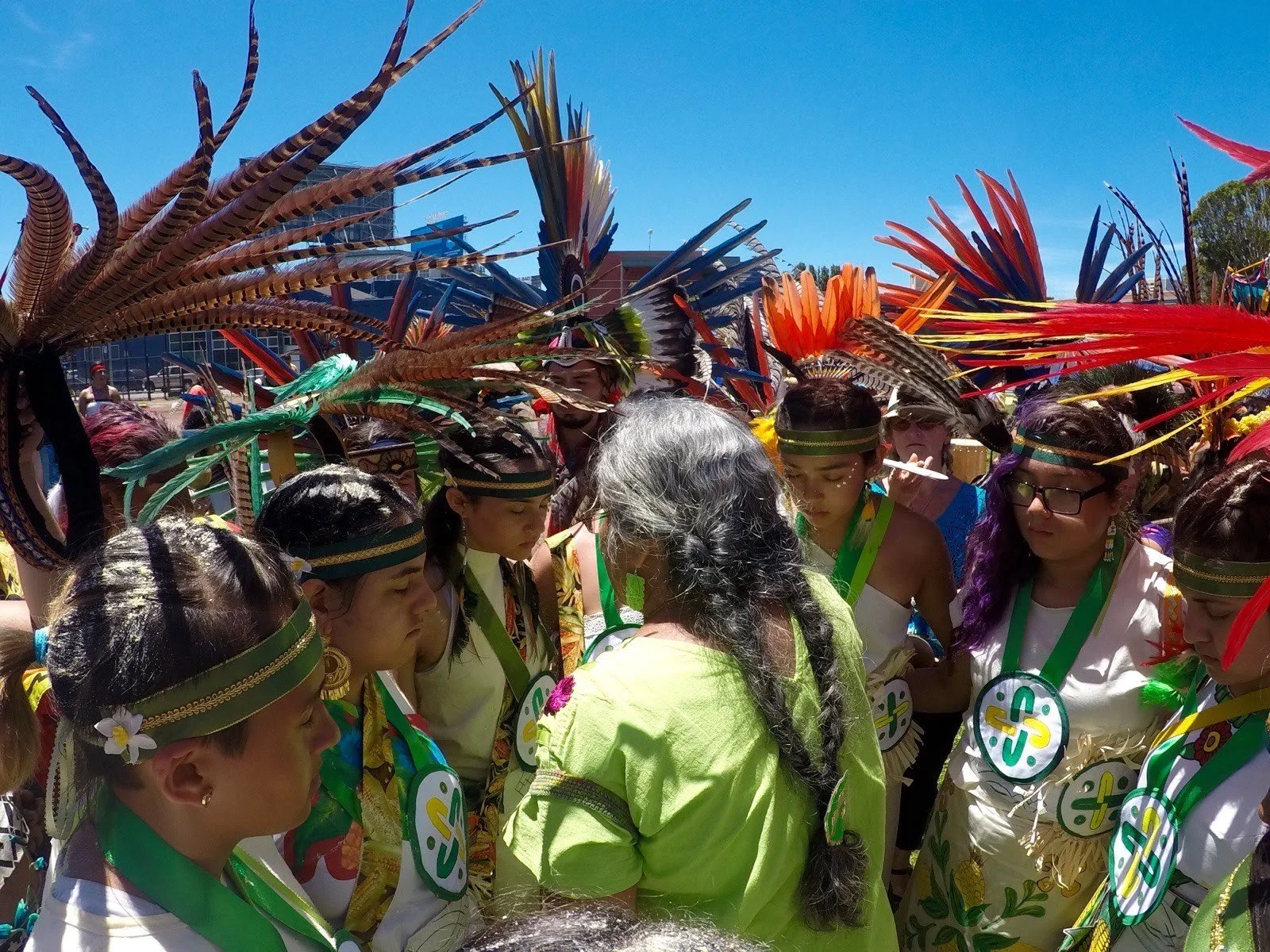Corn, Maiz, Cintli– the food of our ancestors, corn is revered as sacred for the indigenous peoples of the Americas, from North and south, transcending la frontera, and time. Maiz represents the indigenous connection to our earth, our sustenance, we are nurtured by corn, and its beautiful patterns, and assortment of colors. In many of our indigenous creation stories, we are descended from corn. For the Aztecas, maize is honored as sacred, often depicted in art, and personifications of the elements, nature, and sacred beings. One of the representations being that of Xilonen– tender corn.
Trajes, regalia, painted with images of corn. Photo by Anastacia Powers
In the Chichimeca-Otomi tradition, better known as Danza Azteca, we hold many ceremonies throughout the year to honor our community, and spirituality including ceremonies to honor Women, Men, Ancestors, Two-Spirits, Children, and the transition from childhood to adulthood. For young women in Danza, our rite of passage is depicted by the transformation of corn, and the goddess of Maiz, tender corn, Xilonen. Growing up in the tradición of Danza, I always knew I would be a Xilonen, and looked forward to the day of my ceremony. As a young girl in the circle I idolized Xilonen, the young women in my community adorned in Manta (muslin cloth) and elements of green, and gold– showered with love, consejos (advice), and prayer through song and dance. And we never fall short of corn metaphors. Xilonen ceremony is a day where as a young woman we are the center, surrounded by a community excited to welcome, and guide us into our transition to young womanhood. As a young girl, I watched as the young women in my family became Xilonen, and I felt as though my ceremony could not come soon enough. I studied the dances, mannerisms, eavesdropped on their prayers– being a Xilonen was what I was born to become, a young honorable woman of the community, guided by tradicion, and driven by ancestral teachings.
The year of my ceremony finally approached-- I say year, because it takes a year of preparation, and a year of completion. I was fortunate enough to share my year of ceremony with comadres, and sisters I grew up with, including their incredible mothers who guided us every step of the way. This made my ceremony that much more special. We met every Sunday of the year to discuss ceremony prep– of course a year in advance we decided on the Taquero, and to serve elote en vaso, that was the one sure thing. On a ceremonial note, we learned about the importance of ofrenda, giving ourselves to the community, and how to carry ourselves in ceremony. We learned how to dry and wrap herbs, and how to hand-embroider– in order to create an art piece that represented us to place on the altar. I decided on the Black/Brown Power fist, with corn representing the four directions emerging from the fist– it was quite ambitious, but I managed. We designed, and created our trajes (regalia), and chose godparents– those who we trusted and held close to our hearts in order to help guide us on our journeys. A whole year of preparation, for a ceremony that seemed to pass by in one minute.
Xilonen in a circle, receiving words of wisdom from elder, Guadalupe Avila. Photo by Josue Arguelles.
What I do remember is how content I felt, fulfilled. The sun beamed so bright that day, and so did everyone's smiles, the circle felt like un abrazo. I watched one of my comadres step into her traje (regalia), and mask of Xilonen, and offer the dance called Maiz– each step representing the journey of the corn, desde la siembra (planting of seeds), to the popping of the kernel. We traveled throughout the circle visiting altars representing the four directions to receive consejos, from the children, to the women, the men, and finally, the elders. An elder Lupe, held us close, and told us to remember the feeling of our ceremony– the love, the pride, and to hold it close in our heart, then, she showered us with cornmeal. I take her advice, I hold this day close to my heart, I remember the sun on this day, I remember the pride I felt in my sisters, my community, my circle. I wish for everyone to feel that sense of love, and guidance one day. It is a blessing to be connected with ancestral traditions, and teachings– ceremonies our ancestors fought to preserve.
Maiz is sacred, and so are the representations of it. The film Guardianes del Maiz tells the story of Maiz from the indigenous farmer, artisans and cooks in Mexico whose ancestors shepherded the ever-evolving seeds from the dawn of agriculture into the 21st Century. These voices are joined by community leaders, scientists, chefs, and others whose knowledge and activism stand not only in defense of food sovereignty and the genetic integrity, diversity, and community ownership of native seeds, but in defense of a durable cultural legacy and a way of life.
This blog post was written by Aztaxelli “Xela” Vargas Brava’s Social Media Intern. Xela is an indigenous, Xica-Nica, SF native with a family legacy in the arts, poetry, and social activism. She is a student at CCSF currently studying Ethnic Studies, and Sociology, and in her freetime enjoys walking through the neighborhood and creating Art. For inquiries you can reach her through xela@brava.org.



